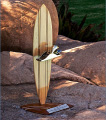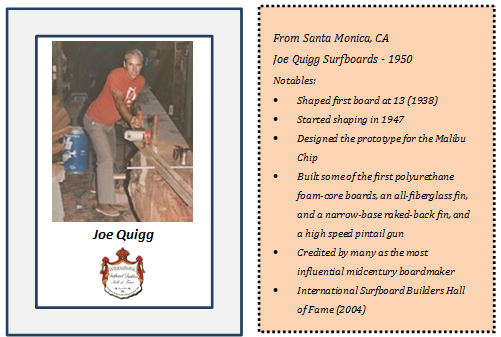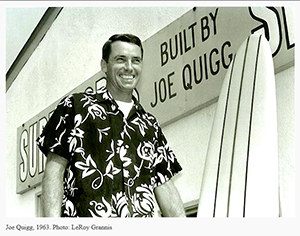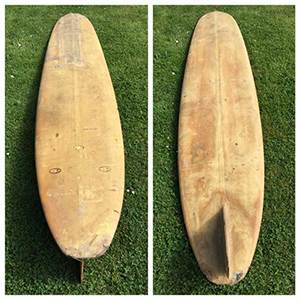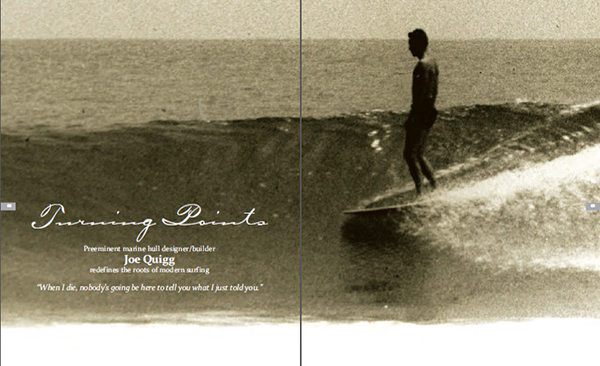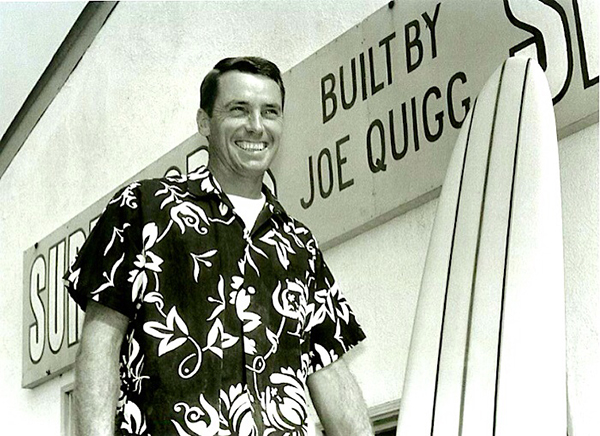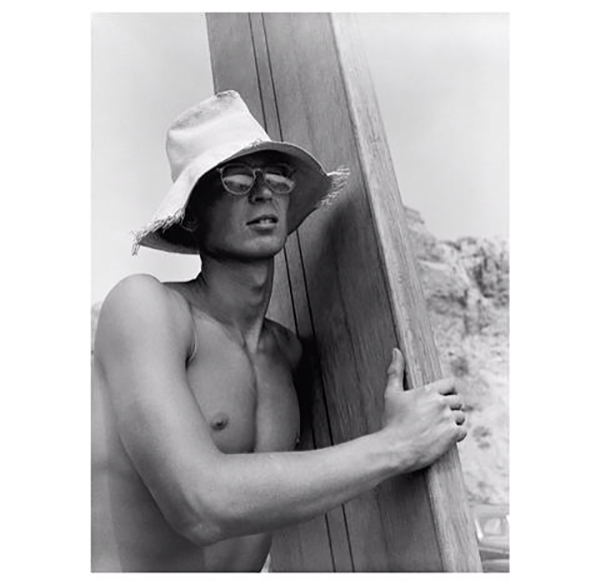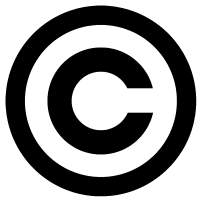International Surfboard Builders Hall Of Fame Inductee Details
Sadly, over the years websites that have links here will change or be abandoned from the time that they were posted here so the will not be found.
| Inductee Name Joe Quigg | Event Year 2004 | Inductee Location North Shore of Oahu, Hawaii | Inductee Contact gordon@quiggsurfboards.com (808) 277-0114 |
| Inductee Brand | 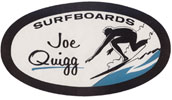
|
||
| Inductee Boardshop Quigg Sufrboards |
Boardshop Link http://www.quiggsurfboards.com/ |
| Inductee Bio Virtuoso surfboard designer and craftsman, originally from Santa Monica, California; co-founder of both the modern longboard and the specialized big-wave board, and credited by many as the most influential midcentury boardmaker. Quigg was born (1925) in Los Angeles, raised in Santa Monica, and began surfing at age four, after building himself a small wooden bellyboard. At 13 he made a redwood board that had slightly upturned nose and tail sections (later called "rocker"), which allowed greater maneuverability and made the board more forgiving in tight places; the solid-wood plank boards in use at the time, as well as the hollow paddleboard-surfboards, were flat from bow to stern. Quigg would later say that the rocker was his greatest contribution to surfboard design. After four years in the navy, Quigg returned to Santa Monica in 1947, bought a surfboard that didn't perform well, and vowed to make his own boards from then on. He became part of a small group of surfer-designers, including Bob Simmons and Matt Kivlin, who used Malibu as a test track. Quigg's boards immediately earned a reputation as fast and well-made; in keeping with the times, however, his shapes were wide, heavy, blunt, and buoyant. In 1947, Quigg built a balsa-redwood board for Darrylin Zanuck, a beginning teenage surfer and the daughter of Hollywood mogul Darryl Zanuck, that was thinner and lighter than anything yet seen; the 25-pound "Darrylin board," as it was called, got passed from one Malibu surfer to the next as the hottest-turning board on the beach, and thus became a prototype for the popular Malibu chip board. That same year, along with Malibu icon Bob Simmons, Quigg built in succession some of the first polyurethane foam-core boards, an all-fiberglass fin, and a narrow-base raked-back fin; each idea would become standard in years to come. In 1948, after dreaming of a board fast enough to make a wave from the top of the point at Rincon—a Malibu-like wave near Santa Barbara—Quigg cut his board in half longitudinally, removed two inches (reducing the board's width from 23 to 21 inches), glued it back together, and created the first pintail board, designed to hold traction at higher speeds. Quigg's pintail was a forerunner of the big-wave board. He made boards for Tom Zahn in the late '40s and early '50s—Zahn was one of the best riders at Malibu, along with Kivlin and Les Williams—and for pioneering big-wave surfer Buzzy Trent in the mid-'50s. When Trent ordered a 12-foot big-wave board from Quigg, he memorably asked the shaper to build him an "elephant gun," to be used for hunting down giant waves. Big-wave boards have since been known as guns. Quigg founded a production-retail surfboard shop in Santa Monica in 1950, then opened a similar shop in Honolulu in 1953, after moving to Oahu. Years earlier, Quigg had taken photography classes at the Art Center College of Design in Los Angeles; he quit one semester before graduating, but went on to shoot some of the best surf photos of the late '40s and '50s. Quigg lived in Newport Beach, California, from 1959 to 1969, then moved back to Hawaii, where he built boats, canoes, and paddleboards until retiring in 1987. He was known as one of surfing's slowest and most meticulous workers, and made just 4,000 boards in his career—tens of thousands fewer than some other long-term shapers. Quigg married Aggie Bane, one of the first and best female surfers at Malibu, in 1950; they have two children. He was inducted into the International Surfing Hall of Fame in 1991. By: Lorelei Viola Ranney, Facebook March 19 2018 Contributing To This Entry LeRoy Grannis, Joe Quigg | |||
| For the complete biography, go to: http://www.clubofthewaves.com/surf-culture/surfing-pioneers.php | |||

Thanks to: http://encyclopediaofsurfing.com/entries/quigg-joe 1963 photo by LeRoy Grannis for the photo | |||
Links |

